Wenxuan Liu
SU-YOLO: Spiking Neural Network for Efficient Underwater Object Detection
Mar 31, 2025Abstract:Underwater object detection is critical for oceanic research and industrial safety inspections. However, the complex optical environment and the limited resources of underwater equipment pose significant challenges to achieving high accuracy and low power consumption. To address these issues, we propose Spiking Underwater YOLO (SU-YOLO), a Spiking Neural Network (SNN) model. Leveraging the lightweight and energy-efficient properties of SNNs, SU-YOLO incorporates a novel spike-based underwater image denoising method based solely on integer addition, which enhances the quality of feature maps with minimal computational overhead. In addition, we introduce Separated Batch Normalization (SeBN), a technique that normalizes feature maps independently across multiple time steps and is optimized for integration with residual structures to capture the temporal dynamics of SNNs more effectively. The redesigned spiking residual blocks integrate the Cross Stage Partial Network (CSPNet) with the YOLO architecture to mitigate spike degradation and enhance the model's feature extraction capabilities. Experimental results on URPC2019 underwater dataset demonstrate that SU-YOLO achieves mAP of 78.8% with 6.97M parameters and an energy consumption of 2.98 mJ, surpassing mainstream SNN models in both detection accuracy and computational efficiency. These results underscore the potential of SNNs for engineering applications. The code is available in https://github.com/lwxfight/snn-underwater.
Foveated Instance Segmentation
Mar 27, 2025Abstract:Instance segmentation is essential for augmented reality and virtual reality (AR/VR) as it enables precise object recognition and interaction, enhancing the integration of virtual and real-world elements for an immersive experience. However, the high computational overhead of segmentation limits its application on resource-constrained AR/VR devices, causing large processing latency and degrading user experience. In contrast to conventional scenarios, AR/VR users typically focus on only a few regions within their field of view before shifting perspective, allowing segmentation to be concentrated on gaze-specific areas. This insight drives the need for efficient segmentation methods that prioritize processing instance of interest, reducing computational load and enhancing real-time performance. In this paper, we present a foveated instance segmentation (FovealSeg) framework that leverages real-time user gaze data to perform instance segmentation exclusively on instance of interest, resulting in substantial computational savings. Evaluation results show that FSNet achieves an IoU of 0.56 on ADE20K and 0.54 on LVIS, notably outperforming the baseline. The code is available at https://github.com/SAI-
SpikeDerain: Unveiling Clear Videos from Rainy Sequences Using Color Spike Streams
Mar 26, 2025Abstract:Restoring clear frames from rainy videos presents a significant challenge due to the rapid motion of rain streaks. Traditional frame-based visual sensors, which capture scene content synchronously, struggle to capture the fast-moving details of rain accurately. In recent years, neuromorphic sensors have introduced a new paradigm for dynamic scene perception, offering microsecond temporal resolution and high dynamic range. However, existing multimodal methods that fuse event streams with RGB images face difficulties in handling the complex spatiotemporal interference of raindrops in real scenes, primarily due to hardware synchronization errors and computational redundancy. In this paper, we propose a Color Spike Stream Deraining Network (SpikeDerain), capable of reconstructing spike streams of dynamic scenes and accurately removing rain streaks. To address the challenges of data scarcity in real continuous rainfall scenes, we design a physically interpretable rain streak synthesis model that generates parameterized continuous rain patterns based on arbitrary background images. Experimental results demonstrate that the network, trained with this synthetic data, remains highly robust even under extreme rainfall conditions. These findings highlight the effectiveness and robustness of our method across varying rainfall levels and datasets, setting new standards for video deraining tasks. The code will be released soon.
Towards Event Extraction with Massive Types: LLM-based Collaborative Annotation and Partitioning Extraction
Mar 04, 2025Abstract:Developing a general-purpose extraction system that can extract events with massive types is a long-standing target in Event Extraction (EE). In doing so, the challenge comes from two aspects: 1) The absence of an efficient and effective annotation method. 2) The absence of a powerful extraction method can handle massive types. For the first challenge, we propose a collaborative annotation method based on Large Language Models (LLMs). Through collaboration among multiple LLMs, it first refines annotations of trigger words from distant supervision and then carries out argument annotation. Next, a voting phase consolidates the annotation preferences across different LLMs. Finally, we create the EEMT dataset, the largest EE dataset to date, featuring over 200,000 samples, 3,465 event types, and 6,297 role types. For the second challenge, we propose an LLM-based Partitioning EE method called LLM-PEE. To overcome the limited context length of LLMs, LLM-PEE first recalls candidate event types and then splits them into multiple partitions for LLMs to extract events. The results in the supervised setting show that LLM-PEE outperforms the state-of-the-art methods by 5.4 in event detection and 6.1 in argument extraction. In the zero-shot setting, LLM-PEE achieves up to 12.9 improvement compared to mainstream LLMs, demonstrating its strong generalization capabilities.
FovealNet: Advancing AI-Driven Gaze Tracking Solutions for Optimized Foveated Rendering System Performance in Virtual Reality
Dec 12, 2024



Abstract:Leveraging real-time eye-tracking, foveated rendering optimizes hardware efficiency and enhances visual quality virtual reality (VR). This approach leverages eye-tracking techniques to determine where the user is looking, allowing the system to render high-resolution graphics only in the foveal region-the small area of the retina where visual acuity is highest, while the peripheral view is rendered at lower resolution. However, modern deep learning-based gaze-tracking solutions often exhibit a long-tail distribution of tracking errors, which can degrade user experience and reduce the benefits of foveated rendering by causing misalignment and decreased visual quality. This paper introduces \textit{FovealNet}, an advanced AI-driven gaze tracking framework designed to optimize system performance by strategically enhancing gaze tracking accuracy. To further reduce the implementation cost of the gaze tracking algorithm, FovealNet employs an event-based cropping method that eliminates over $64.8\%$ of irrelevant pixels from the input image. Additionally, it incorporates a simple yet effective token-pruning strategy that dynamically removes tokens on the fly without compromising tracking accuracy. Finally, to support different runtime rendering configurations, we propose a system performance-aware multi-resolution training strategy, allowing the gaze tracking DNN to adapt and optimize overall system performance more effectively. Evaluation results demonstrate that FovealNet achieves at least $1.42\times$ speed up compared to previous methods and 13\% increase in perceptual quality for foveated output.
See What You Seek: Semantic Contextual Integration for Cloth-Changing Person Re-Identification
Dec 02, 2024



Abstract:Cloth-changing person re-identification (CC-ReID) aims to match individuals across multiple surveillance cameras despite variations in clothing. Existing methods typically focus on mitigating the effects of clothing changes or enhancing ID-relevant features but often struggle to capture complex semantic information. In this paper, we propose a novel prompt learning framework, Semantic Contextual Integration (SCI), for CC-ReID, which leverages the visual-text representation capabilities of CLIP to minimize the impact of clothing changes and enhance ID-relevant features. Specifically, we introduce Semantic Separation Enhancement (SSE) module, which uses dual learnable text tokens to separately capture confounding and clothing-related semantic information, effectively isolating ID-relevant features from distracting clothing semantics. Additionally, we develop a Semantic-Guided Interaction Module (SIM) that uses orthogonalized text features to guide visual representations, sharpening the model's focus on distinctive ID characteristics. This integration enhances the model's discriminative power and enriches the visual context with high-dimensional semantic insights. Extensive experiments on three CC-ReID datasets demonstrate that our method outperforms state-of-the-art techniques. The code will be released at github.
OccludeNet: A Causal Journey into Mixed-View Actor-Centric Video Action Recognition under Occlusions
Nov 24, 2024Abstract:The lack of occlusion data in commonly used action recognition video datasets limits model robustness and impedes sustained performance improvements. We construct OccludeNet, a large-scale occluded video dataset that includes both real-world and synthetic occlusion scene videos under various natural environments. OccludeNet features dynamic tracking occlusion, static scene occlusion, and multi-view interactive occlusion, addressing existing gaps in data. Our analysis reveals that occlusion impacts action classes differently, with actions involving low scene relevance and partial body visibility experiencing greater accuracy degradation. To overcome the limitations of current occlusion-focused approaches, we propose a structural causal model for occluded scenes and introduce the Causal Action Recognition (CAR) framework, which employs backdoor adjustment and counterfactual reasoning. This framework enhances key actor information, improving model robustness to occlusion. We anticipate that the challenges posed by OccludeNet will stimulate further exploration of causal relations in occlusion scenarios and encourage a reevaluation of class correlations, ultimately promoting sustainable performance improvements. The code and full dataset will be released soon.
AlignXIE: Improving Multilingual Information Extraction by Cross-Lingual Alignment
Nov 07, 2024
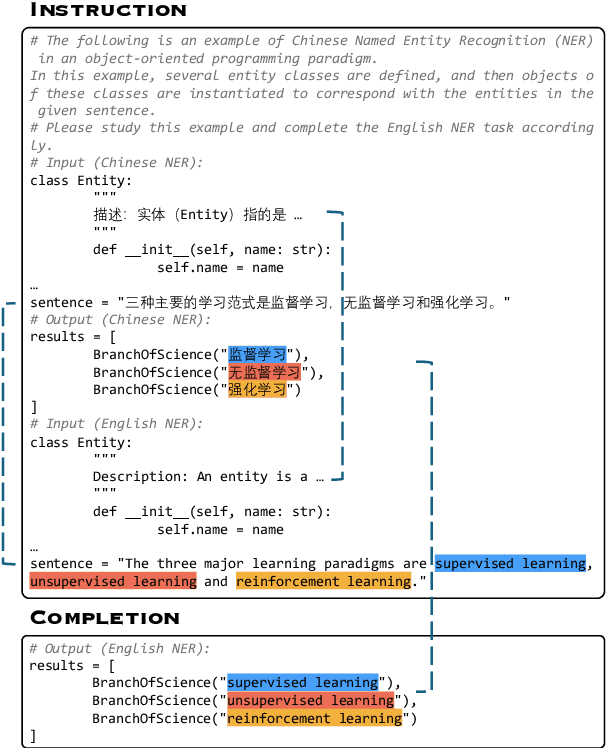

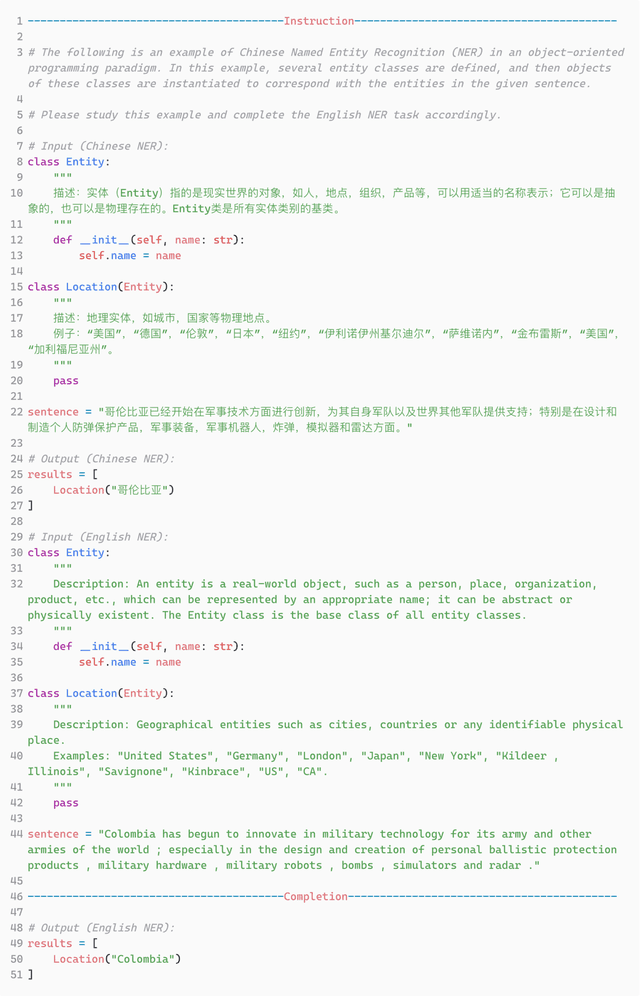
Abstract:Empirical evidence suggests that LLMs exhibit spontaneous cross-lingual alignment. Our findings suggest that although LLMs also demonstrate promising cross-lingual alignment in Information Extraction, there remains significant imbalance across languages, revealing an underlying deficiency in the IE alignment. To address this issue, we propose AlignXIE, a powerful code-based LLM that significantly enhances cross-lingual IE alignment through two strategies. Firstly, AlignXIE formulates IE across different languages, especially non-English ones, as code generation tasks, standardizing the representation of various schemas using Python classes to ensure consistency of the same ontology in different languages and align the schema. Secondly, it incorporates an IE cross-lingual alignment phase through a translated instance prediction task proposed in this paper to align the extraction process, utilizing ParallelNER, an IE bilingual parallel dataset with 257,190 samples, generated by our proposed LLM-based automatic pipeline for IE parallel data construction, with manual annotation to ensure quality. Ultimately, we obtain AlignXIE through multilingual IE instruction tuning. Although without training in 9 unseen languages, AlignXIE surpasses ChatGPT by $30.17\%$ and SoTA by $20.03\%$, thereby demonstrating superior cross-lingual IE capabilities. Comprehensive evaluations on 63 IE benchmarks in Chinese and English under various settings, demonstrate that AlignXIE significantly enhances cross-lingual and multilingual IE through boosting the IE alignment.
HQ-DiT: Efficient Diffusion Transformer with FP4 Hybrid Quantization
May 31, 2024



Abstract:Diffusion Transformers (DiTs) have recently gained substantial attention in both industrial and academic fields for their superior visual generation capabilities, outperforming traditional diffusion models that use U-Net. However,the enhanced performance of DiTs also comes with high parameter counts and implementation costs, seriously restricting their use on resource-limited devices such as mobile phones. To address these challenges, we introduce the Hybrid Floating-point Quantization for DiT(HQ-DiT), an efficient post-training quantization method that utilizes 4-bit floating-point (FP) precision on both weights and activations for DiT inference. Compared to fixed-point quantization (e.g., INT8), FP quantization, complemented by our proposed clipping range selection mechanism, naturally aligns with the data distribution within DiT, resulting in a minimal quantization error. Furthermore, HQ-DiT also implements a universal identity mathematical transform to mitigate the serious quantization error caused by the outliers. The experimental results demonstrate that DiT can achieve extremely low-precision quantization (i.e., 4 bits) with negligible impact on performance. Our approach marks the first instance where both weights and activations in DiTs are quantized to just 4 bits, with only a 0.12 increase in sFID on ImageNet.
KnowCoder: Coding Structured Knowledge into LLMs for Universal Information Extraction
Mar 14, 2024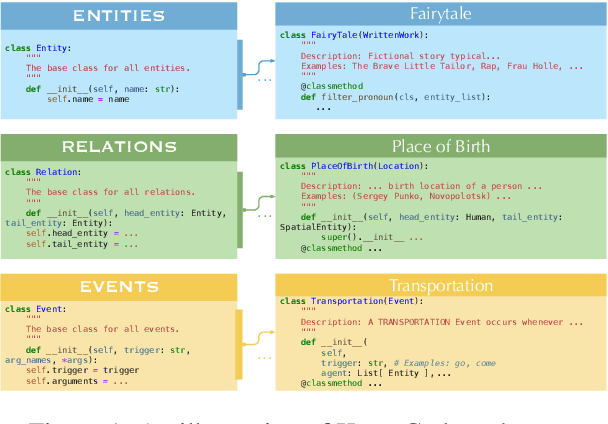

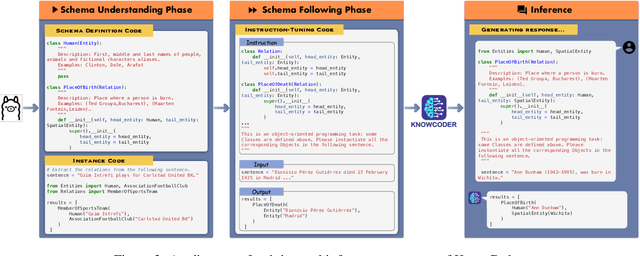
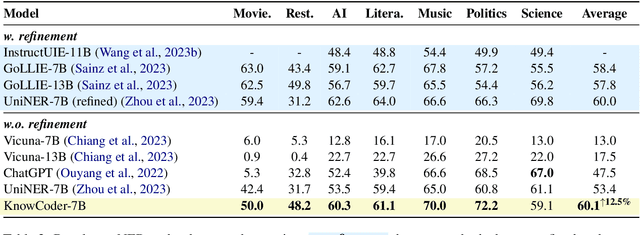
Abstract:In this paper, we propose KnowCoder, a Large Language Model (LLM) to conduct Universal Information Extraction (UIE) via code generation. KnowCoder aims to develop a kind of unified schema representation that LLMs can easily understand and an effective learning framework that encourages LLMs to follow schemas and extract structured knowledge accurately. To achieve these, KnowCoder introduces a code-style schema representation method to uniformly transform different schemas into Python classes, with which complex schema information, such as constraints among tasks in UIE, can be captured in an LLM-friendly manner. We further construct a code-style schema library covering over $\textbf{30,000}$ types of knowledge, which is the largest one for UIE, to the best of our knowledge. To ease the learning process of LLMs, KnowCoder contains a two-phase learning framework that enhances its schema understanding ability via code pretraining and its schema following ability via instruction tuning. After code pretraining on around $1.5$B automatically constructed data, KnowCoder already attains remarkable generalization ability and achieves relative improvements by $\textbf{49.8%}$ F1, compared to LLaMA2, under the few-shot setting. After instruction tuning, KnowCoder further exhibits strong generalization ability on unseen schemas and achieves up to $\textbf{12.5%}$ and $\textbf{21.9%}$, compared to sota baselines, under the zero-shot setting and the low resource setting, respectively. Additionally, based on our unified schema representations, various human-annotated datasets can simultaneously be utilized to refine KnowCoder, which achieves significant improvements up to $\textbf{7.5%}$ under the supervised setting.
 Add to Chrome
Add to Chrome Add to Firefox
Add to Firefox Add to Edge
Add to Edge